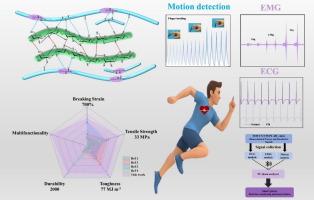Multi-hydrogen bond induced double crosslinked network based on WPU/BC/MWCNTs for high ductility and reliable electronic skin for multimodal health monitoring
IF 13.2
1区 工程技术
Q1 ENGINEERING, CHEMICAL
引用次数: 0
Abstract
Flexible electronic skins (e-skins) that offer high sensitivity, durability, and long-term stability are essential for wearable sensing applications; however, achieving a balance between conductivity, mechanical flexibility, and stability remains a significant challenge. This study, addresses these issues by developing a highly elastic, waterborne polyurethane (WPU) composite incorporating bacterial cellulose (BC) and multi-walled carbon nanotubes (MWCNTs). The abundant hydroxyl groups in BC form strong hydrogen bonds with polyurethane, resulting in a dual cross-linking network that mechanical strength and facilitates MWCNTs dispersion through hydrophilic-hydrophobic synergy, thereby significantly improving electrical conductivity. In addition, BC modulates the crystallinity of the composite, directly affecting both its mechanical properties and electrical performance. Consequently, the WPU-BC composite film exhibited a tensile strength of 43.6 MPa, 700 % elongation at break, and toughness of 122 MJ/m3, demonstrating outstanding mechanical properties. Furthermore, the MWCNTs/WPU-BC composite film exhibited high conductivity (24.67 S/cm), rapid response time (152.4 ms), and minimal performance degradation after 2000 stretching cycles. These synergistic properties enable flexible e-skins to consistently capture bioelectrical and biomechanical signals over extended periods, highlighting their potential as multimodal health monitoring systems. This study underscores the effective modulation of composite microstructures via hydrogen bonding and crystallinity control, providing a novel approach for developing durable, sensitive, and biocompatible e-skins. This strategy addresses critical challenges in soft-sensor applications.

基于WPU/BC/MWCNTs的高延展性、可靠的多模态健康监测电子皮肤的多氢键诱导双交联网络
提供高灵敏度,耐用性和长期稳定性的柔性电子皮肤(e-skin)对于可穿戴传感应用至关重要;然而,在导电性、机械柔韧性和稳定性之间取得平衡仍然是一个重大挑战。本研究通过开发一种含有细菌纤维素(BC)和多壁碳纳米管(MWCNTs)的高弹性水性聚氨酯(WPU)复合材料来解决这些问题。BC中丰富的羟基与聚氨酯形成强氢键,形成双交联网络,提高机械强度,并通过亲疏水协同作用促进MWCNTs分散,从而显著提高导电性。此外,BC调节复合材料的结晶度,直接影响其机械性能和电气性能。结果表明,WPU-BC复合膜的抗拉强度为43.6 MPa,断裂伸长率为700 %,韧性为122 MJ/m3,具有优异的力学性能。此外,MWCNTs/WPU-BC复合膜具有高电导率(24.67 S/cm)、快速响应时间(152.4 ms)和2000次拉伸循环后性能下降最小的特点。这些协同特性使柔性电子皮肤能够长时间持续捕获生物电和生物力学信号,突出了其作为多模式健康监测系统的潜力。这项研究强调了通过氢键和结晶度控制对复合材料微观结构的有效调节,为开发耐用、敏感和生物相容性好的电子皮肤提供了一种新的方法。该策略解决了软传感器应用中的关键挑战。
本文章由计算机程序翻译,如有差异,请以英文原文为准。
求助全文
约1分钟内获得全文
求助全文
来源期刊

Chemical Engineering Journal
工程技术-工程:化工
CiteScore
21.70
自引率
9.30%
发文量
6781
审稿时长
2.4 months
期刊介绍:
The Chemical Engineering Journal is an international research journal that invites contributions of original and novel fundamental research. It aims to provide an international platform for presenting original fundamental research, interpretative reviews, and discussions on new developments in chemical engineering. The journal welcomes papers that describe novel theory and its practical application, as well as those that demonstrate the transfer of techniques from other disciplines. It also welcomes reports on carefully conducted experimental work that is soundly interpreted. The main focus of the journal is on original and rigorous research results that have broad significance. The Catalysis section within the Chemical Engineering Journal focuses specifically on Experimental and Theoretical studies in the fields of heterogeneous catalysis, molecular catalysis, and biocatalysis. These studies have industrial impact on various sectors such as chemicals, energy, materials, foods, healthcare, and environmental protection.
文献相关原料
公司名称
产品信息
阿拉丁
trimethylolpropane (TMP)
阿拉丁
dihydroxymethylpropionic acid (DMPA)
阿拉丁
polycarbonate diol (PCDL2000)
阿拉丁
polytetrahydrofuran (PTMG2000)
阿拉丁
Isophorone diisocyanate (IPDI)
 求助内容:
求助内容: 应助结果提醒方式:
应助结果提醒方式:


